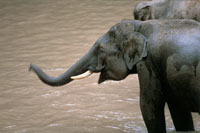




BANGKOK—The global trade in ivory is still on the rise despite a worldwide ban, driven mostly by demand in China, experts said ahead of a top-level meeting on flora and fauna here in October.
“Unregulated ivory markets continue to drive the illegal killing of thousands of elephants annually,” the Southeast Asia director of the wildlife trade monitoring group TRAFFIC, James Compton, told reporters.
He said China had done the most out of those nations to crack down on the illegal trade, but warned it was still importing vast quantities of smuggled ivory from Asia and Africa. “The Chinese market is still the biggest influence in the upward trend in the ivory trade,” he said.
Large animals like elephants, lions, whales and sharks are set to take center stage at the meeting on the Convention on International Trade in Endangered Species of Wild Fauna and Flora (CITES) from Oct. 2-14. Delegates will review protection measures to regulate the global trade in endangered plants and animals.
"The Chinese market is still the biggest influence in the upward trend in the ivory trade."
Many wildlife protection officials and animal activists converging on Bangkok see regulating strong demand for endangered species and their products in China and Southeast Asia as the key to survival for many species.
TRAFFIC says China is a major destination and source country for medicines, ornaments, and clothes made from almost every endangered species favored by smugglers, although it also points out that most of the new information comes as a result of a government crackdown.
But the group also said that loose laws in Thailand meant that locally produced ivory was mixed in the marketplace with ivory smuggled from Africa from the illegal killing of elephants. It is impossible to distinguish the two kinds without certification.
TRAFFIC has also identified flourishing ivory markets, both legal and illegal, in the United States, according to a recent report on its Web site.
African elephants have been historically over-exploited by dramatic levels of poaching for the international trade in ivory. They also face dwindling wild habitat and increasing conflict with humans. In 1979 there were over 1,300,000 elephants across Africa. A decade later this had been cut to just over 600,000, a drop of more than 50 percent in 10 years.
CITES is an agreement signed by 166 governments to ensure that international trade in wild animals and plants doesn’t threaten their survival and imposes controls on international trade in species. CITES regulations apply to live animals as well as body parts, such as ivory from elephant tusks or the fur of a fox or seal.
On the Web:
TRAFFIC report on the U.S. ivory market
TRAFFIC article on the rise in wildlife trade in Southeast Asia
Listen to a recording by the Thai Elephant Orchestra (Mulatta Records)